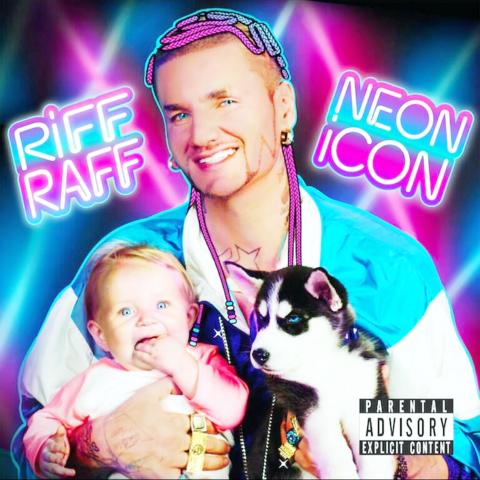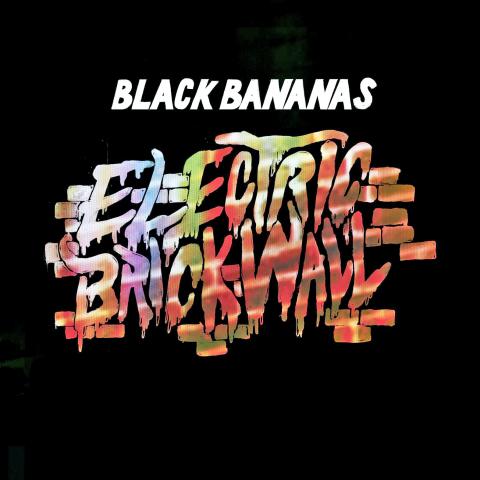Neon Icon
Riff Raff
Mad Decent
Alter egos — Riff Raff’s had a few. There are Jody Highroller, Kokayne Dawkinz and any of the hundreds of off-the-cuff monikers he bestows upon himself in song or on Twitter. Riff Raff is malleable, a canvas forever in need of fresh paint.
In this fashion, he’s carved out a sui generis hip-hop career in the last few years, popping up in unlikely places with unlikely friends (everyone from Drake to Chief Keef) and rapping unlikely lyrics in unlikely structures.

No sense trying to diagram his sentences: He drops prepositions at will and turns nouns into adverbs. At his best, he’s a master of psychedelic free association, with non sequitur lyrics full of 10-point words that are rapped as if he had come up with the idea for the line just after it began, then rushed to finish it on beat.
Neon Icon is Riff Raff’s debut album, though that’s more a liability than an achievement at this point in the gag. An album implies seriousness, a certain sense of decorum — generally speaking, things Riff Raff would rather not bother with.
And, indeed, Neon Icon is a fine hip-hop album from someone who seemed as if he’d make anything but. It’s dispiriting to hear Riff Raff contort himself into the shape of a mediocre pop-rap song like Maybe You Love Me or to be scraped clean of all his idiosyncrasy on Time, an otherwise amusing country-rap tune.

On those songs, he’s mindful of the beat and how he fits into it, as opposed to rapping forcefully and ridiculously in his fundamentally unmimickable style. (Well, that’s not wholly true — Mac Miller does a worthy impression of it in parts of his verse on Aquaberry Dolphin.) The Riff Raff of old is still there on Lava Glaciers, with the jumbled couplet “Ate the pork chop sandwich with the tartar sauce/In the packet that I found in my purple Prada pocket protector.” And throughout, there are tossed-off lines that sparkle — “I can shoot a BB through a frosted Cheerio,” “I could freestyle to a dolphin and a tambourine” — and reassert Riff Riff’s innovative gifts.
To suggest, though, that this professional absurdist isn’t grounded in any hip-hop traditions is willful ignorance. He is a child of Houston, its tics and idiosyncrasies. He can mimic the blurred aesthetic of DJ Screw’s chopped-and-screwed remixes using only his mouth. On this album, the city’s slow creep is there on Tip Toe Wing in My Jawwwdinz, and he nods to its history on the album closing remix of How to Be the Man, which features the established hometown stars Slim Thug and Paul Wall. This swinging, effective, straight-ahead song, with a few oddball Riff Raff flourishes, fully cements his path from area weirdo to living, breathing, viable rap star. Call him Whimsy Houston.
— Jon Caramanica

Phox
Phox
Partisan
Monica Martin, the lead singer of Phox, usually sounds so blithe and nonchalant that it takes a while to notice how her songs teeter amid reassurance and anxiety, companionship and betrayal. “You may taste the salt that rolls off my cheekbone,” she sings in Slow Motion, “but you don’t know why I cry.”
Phox was formed by six small-town high school friends from Baraboo, Wisconsin, who started the band while sharing a house in nearby Madison. Martin writes lyrics and melodies; the whole band collaborates on the music, which has the amiable lilt and handmade eccentricity that find a welcome in college towns. There’s a touch of Dave Matthews in the acoustic syncopations of the music, and a larger dollop of Feist, both in Martin’s airy sustained vocals and in meticulous arrangements that can start out sparse but suddenly seem to gather a houseful of musicians.
Phox and its producer, Brian Joseph (a recording engineer for Bon Iver who worked with the band at Bon Iver’s April Base Studios), make the most of studio flexibility in songs that develop and transform themselves radically as they go. Shrinking Violet — a tentative, promising liaison that finds “two shrinking violets at full bloom”— opens with the lightest of drum taps, a repeated guitar note and a plinking banjo. But as the romance solidifies, Phox becomes a rock band flanked by saxophones and, later, what sounds like a glockenspiel-topped marching band. (The Baraboo High School Symphony Band is credited as the album’s orchestra.) Slow Motion sometimes has a leisurely reggae bass, sometimes a crisp drum-line beat, sometimes a canopy of pretty chamber-pop, sometimes a zany counterpoint of group whistling, yet maintains a nearly miraculous continuity.
All the changes in the music elucidate songs in which love, friendship and family ties are always in flux. In the bouncy, chipper-sounding Evil, the singer catches her lover and her best friend in the act of cheating, “telling me that you don’t want to hurt me;” hurt and anger gradually give way to the consolation that “evil will find its own demise.”
In 1936, the singer strives to patch things up with an ailing grandmother and the other grandchildren: “We will sort our way around this awful mess/That all our genes have thrown around” because “her blood is our blood too,” she sings. She confronts her own temptations in Noble Heart, a ballad that moves between quasi-Baroque piano and a big, reverberant girl-group beat; she warns her love that she’s a “low-level poison” susceptible to “this scarlet lust” but vows to stay loyal. The emotions are convoluted, and Phox finds a winding and ultimately heartening path through them.
— Jon Pareles
Electric Brick Wall
Black Bananas
Drag City
Black Bananas, as a band name, implies organically complicated garbage, rotten and oversweet, thin-surfaced and oozing from the seams. A symbol of decline and neglect. And Electric Brick Wall, the title of its second album: wow. Was that the name of a Fluxus sound-art piece? Did someone once put contact mikes on a wall and then play the wall or let it play itself? I don’t know. But think about what those words imply. Hard and dense but alive. Thick and mineral but juiced, creating output. So: rotten, dense, sweet, radiant. What would that sound like?
Until 2001, Jennifer Herrema was in the great biker-rock art-band Royal Trux, as a snarler-songwriter, her voiced pinched and abrasive. Later she formed RTX, letting her voice fill out and become tuneful, making some straightforward and sometimes thrilling versions of ‘80s Sunset Strip metal. But with nearly the same lineup and a changed name, Black Bananas has both deranged and refined its concept. It’s grown weirder, funkier and more imposing.
Electric Brick Wall, even more than the band’s last record, Rad Times Xpress IV, coheres into songs with good form: rancid bar-band shuffles and Black Sabbath-like riffs, like outtakes from her past bands, but also slow electronic funk and swift ‘80s radio-hit pop grooves, in songs like Physical Emotions and Give It to Me. (Those titles: hard and dumb, but alive!) It’s a 32-minute, 11-song sensorium, layered like years of subway posters: cut a slice in it, and who knows what you’ll find. Outside of Miles Davis’ first electric period and Messiaen’s Turangalila Symphony, I can’t think of music with more density.
This is an art of addition, of arranged piles. Whenever one element in the sound mass takes a rest, you hear what’s festering underneath it: processed drum machines; phased and double-tracked guitars; sirens and twinklings and whizzings; electric piano; Herrema’s voice fed through contours of Auto-Tune.
She’s referring to something, but what is it? George Clinton? Prince? The Dazz Band? The late-’70s Isley Brothers? Or just Daft Punk? Hard to tell through the amazing schmutz. Everything’s overdriven and buried at the same time, yet the strong bones of the songs show through. That’s an accomplishment.
— Ben Ratl
iff

May 26 to June 1 When the Qing Dynasty first took control over many parts of Taiwan in 1684, it roughly continued the Kingdom of Tungning’s administrative borders (see below), setting up one prefecture and three counties. The actual area of control covered today’s Chiayi, Tainan and Kaohsiung. The administrative center was in Taiwan Prefecture, in today’s Tainan. But as Han settlement expanded and due to rebellions and other international incidents, the administrative units became more complex. By the time Taiwan became a province of the Qing in 1887, there were three prefectures, eleven counties, three subprefectures and one directly-administered prefecture, with

It’s an enormous dome of colorful glass, something between the Sistine Chapel and a Marc Chagall fresco. And yet, it’s just a subway station. Formosa Boulevard is the heart of Kaohsiung’s mass transit system. In metro terms, it’s modest: the only transfer station in a network with just two lines. But it’s a landmark nonetheless: a civic space that serves as much more than a point of transit. On a hot Sunday, the corridors and vast halls are filled with a market selling everything from second-hand clothes to toys and house decorations. It’s just one of the many events the station hosts,

Among Thailand’s Chinese Nationalist Party (KMT) villages, a certain rivalry exists between Arunothai, the largest of these villages, and Mae Salong, which is currently the most prosperous. Historically, the rivalry stems from a split in KMT military factions in the early 1960s, which divided command and opium territories after Chiang Kai-shek (蔣介石) cut off open support in 1961 due to international pressure (see part two, “The KMT opium lords of the Golden Triangle,” on May 20). But today this rivalry manifests as a different kind of split, with Arunothai leading a pro-China faction and Mae Salong staunchly aligned to Taiwan.

Two moves show Taichung Mayor Lu Shiow-yen (盧秀燕) is gunning for Chinese Nationalist Party (KMT) party chair and the 2028 presidential election. Technically, these are not yet “officially” official, but by the rules of Taiwan politics, she is now on the dance floor. Earlier this month Lu confirmed in an interview in Japan’s Nikkei that she was considering running for KMT chair. This is not new news, but according to reports from her camp she previously was still considering the case for and against running. By choosing a respected, international news outlet, she declared it to the world. While the outside world